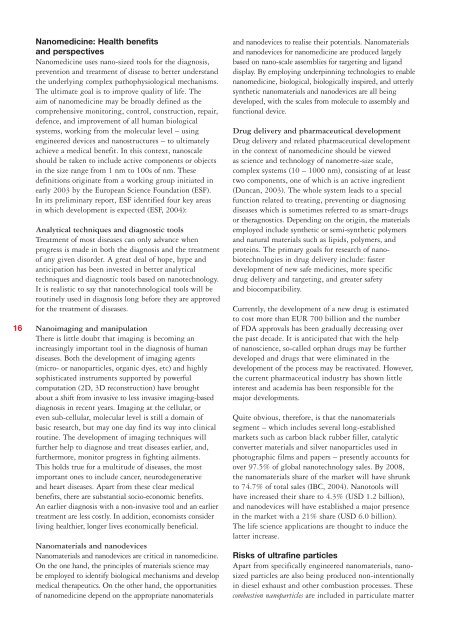Small size - large impact - Nanowerk
Small size - large impact - Nanowerk
Small size - large impact - Nanowerk
You also want an ePaper? Increase the reach of your titles
YUMPU automatically turns print PDFs into web optimized ePapers that Google loves.
16<br />
Nanomedicine: Health benefits<br />
and perspectives<br />
Nanomedicine uses nano-<strong>size</strong>d tools for the diagnosis,<br />
prevention and treatment of disease to better understand<br />
the underlying complex pathophysiological mechanisms.<br />
The ultimate goal is to improve quality of life. The<br />
aim of nanomedicine may be broadly defined as the<br />
comprehensive monitoring, control, construction, repair,<br />
defence, and improvement of all human biological<br />
systems, working from the molecular level – using<br />
engineered devices and nanostructures – to ultimately<br />
achieve a medical benefit. In this context, nanoscale<br />
should be taken to include active components or objects<br />
in the <strong>size</strong> range from 1 nm to 100s of nm. These<br />
definitions originate from a working group initiated in<br />
early 2003 by the European Science Foundation (ESF).<br />
In its preliminary report, ESF identified four key areas<br />
in which development is expected (ESF, 2004):<br />
Analytical techniques and diagnostic tools<br />
Treatment of most diseases can only advance when<br />
progress is made in both the diagnosis and the treatment<br />
of any given disorder. A great deal of hope, hype and<br />
anticipation has been invested in better analytical<br />
techniques and diagnostic tools based on nanotechnology.<br />
It is realistic to say that nanotechnological tools will be<br />
routinely used in diagnosis long before they are approved<br />
for the treatment of diseases.<br />
Nanoimaging and manipulation<br />
There is little doubt that imaging is becoming an<br />
increasingly important tool in the diagnosis of human<br />
diseases. Both the development of imaging agents<br />
(micro- or nanoparticles, organic dyes, etc) and highly<br />
sophisticated instruments supported by powerful<br />
computation (2D, 3D reconstruction) have brought<br />
about a shift from invasive to less invasive imaging-based<br />
diagnosis in recent years. Imaging at the cellular, or<br />
even sub-cellular, molecular level is still a domain of<br />
basic research, but may one day find its way into clinical<br />
routine. The development of imaging techniques will<br />
further help to diagnose and treat diseases earlier, and,<br />
furthermore, monitor progress in fighting ailments.<br />
This holds true for a multitude of diseases, the most<br />
important ones to include cancer, neurodegenerative<br />
and heart diseases. Apart from these clear medical<br />
benefits, there are substantial socio-economic benefits.<br />
An earlier diagnosis with a non-invasive tool and an earlier<br />
treatment are less costly. In addition, economists consider<br />
living healthier, longer lives economically beneficial.<br />
Nanomaterials and nanodevices<br />
Nanomaterials and nanodevices are critical in nanomedicine.<br />
On the one hand, the principles of materials science may<br />
be employed to identify biological mechanisms and develop<br />
medical therapeutics. On the other hand, the opportunities<br />
of nanomedicine depend on the appropriate nanomaterials<br />
and nanodevices to realise their potentials. Nanomaterials<br />
and nanodevices for nanomedicine are produced <strong>large</strong>ly<br />
based on nano-scale assemblies for targeting and ligand<br />
display. By employing underpinning technologies to enable<br />
nanomedicine, biological, biologically inspired, and utterly<br />
synthetic nanomaterials and nanodevices are all being<br />
developed, with the scales from molecule to assembly and<br />
functional device.<br />
Drug delivery and pharmaceutical development<br />
Drug delivery and related pharmaceutical development<br />
in the context of nanomedicine should be viewed<br />
as science and technology of nanometre-<strong>size</strong> scale,<br />
complex systems (10 – 1000 nm), consisting of at least<br />
two components, one of which is an active ingredient<br />
(Duncan, 2003). The whole system leads to a special<br />
function related to treating, preventing or diagnosing<br />
diseases which is sometimes referred to as smart-drugs<br />
or theragnostics. Depending on the origin, the materials<br />
employed include synthetic or semi-synthetic polymers<br />
and natural materials such as lipids, polymers, and<br />
proteins. The primary goals for research of nanobiotechnologies<br />
in drug delivery include: faster<br />
development of new safe medicines, more specific<br />
drug delivery and targeting, and greater safety<br />
and biocompatibility.<br />
Currently, the development of a new drug is estimated<br />
to cost more than EUR 700 billion and the number<br />
of FDA approvals has been gradually decreasing over<br />
the past decade. It is anticipated that with the help<br />
of nanoscience, so-called orphan drugs may be further<br />
developed and drugs that were eliminated in the<br />
development of the process may be reactivated. However,<br />
the current pharmaceutical industry has shown little<br />
interest and academia has been responsible for the<br />
major developments.<br />
Quite obvious, therefore, is that the nanomaterials<br />
segment – which includes several long-established<br />
markets such as carbon black rubber filler, catalytic<br />
converter materials and silver nanoparticles used in<br />
photographic films and papers – presently accounts for<br />
over 97.5% of global nanotechnology sales. By 2008,<br />
the nanomaterials share of the market will have shrunk<br />
to 74.7% of total sales (IBC, 2004). Nanotools will<br />
have increased their share to 4.3% (USD 1.2 billion),<br />
and nanodevices will have established a major presence<br />
in the market with a 21% share (USD 6.0 billion).<br />
The life science applications are thought to induce the<br />
latter increase.<br />
Risks of ultrafine particles<br />
Apart from specifically engineered nanomaterials, nano<strong>size</strong>d<br />
particles are also being produced non-intentionally<br />
in diesel exhaust and other combustion processes. These<br />
combustion nanoparticles are included in particulate matter
















